 This article on Border Terriers is part of a series to highlight the Big Picture of health, welfare and breeding and to help develop Globally Relevant Integrated Health Profiles (GRIHPs) for many breeds. See IPFD's Get a GRIHP! on Breed Health Initiative
This article on Border Terriers is part of a series to highlight the Big Picture of health, welfare and breeding and to help develop Globally Relevant Integrated Health Profiles (GRIHPs) for many breeds. See IPFD's Get a GRIHP! on Breed Health Initiative
There are many others doing great work to advance health, well-being, and welfare in this wonderful breed. We reference and link to terrific work, developments, reports, and research from the UK, USA, Sweden, Finland, and more below. Thanks to all of those working on behalf of Border Terriers.
This is a 'living document' - so if anyone has more material to share or point us to - please let us know!
Breed at a glance
The Border Terrier is a very healthy breed. It has a courageous, tenacious, and independent nature. In many countries, thanks to these traits, Border Terriers are still popular hunting dogs, but also are quite suitable as a family dogs. In the absence of training, the dogs will quickly determine their own rules. With a good education and the patience, the dogs can be obedient, but they nevertheless retain their wilfull character.
Key Health Conditions
Several health conditions are known to occur in Border Terriers, most of them however rare. The most common conditions that can impact the members of the breed are:
-
Orthopedics (patella luxation);
-
Neurological issues including Epilepsy and an episodic movement disorder called Canine Epileptoid Cramping Syndrome (CECS) sometimes known as paroxysmal gluten-sensitive dyskinesia (PGSD) or Spike's Disease;
-
Dental disease (was the most common disorder recorded in Border Terriers in the current study [UK], with 17.63% dogs recorded with periodontal disease)
-
Endocrine disorders such as Cushing's syndrome, hypothyroidism and diabetes mellitus;
-
Gallbladder mucocoele (GBM) see: https://borderterrierhealth.org.uk/gbm.html);
-
Shaking Puppy Syndrome (SPS/SLEM) (see: https://borderterrierhealth.org.uk/sps.html); and
-
Cataracts.
-
The Swedish Agria insurance statistics also lists Neoplasia among the most common diseases (requiring veterinary treatment) and causes of death.
The occurrence and prevalence of health conditions mentioned above may vary from country to country and from family line to family line. Health tests and screening are important tools for breeders to use in selection breeding mates.
What do caretakers need to know
 Many Border Terriers live active lives past 12 up to 14+ years of age.
Many Border Terriers live active lives past 12 up to 14+ years of age.
Daily Exercise: These dogs require daily exercise. They were developed to hunt and to cover ground running with packs of hounds. They will chase and are not reliably tender interacting with small pets such as rabbits, guinea pigs, birds or outdoor cats. Borders should always be walked on a lead unless released in a completely safe, fenced area - the dogs are unreliable off leash. It is important that fencing be secured at ground level as the dogs can be prolific diggers.
Grooming: The Border terrier's coat should be brushed regularly - he is a low to moderate shedder. Hand stripping of the coat twice a year is strongly advised. See the BTCA's Grooming Guide. Regular teeth brushing is suggested.
Expected Demeanor: Border terriers are known to be athletic, enthusiastic, and can have a stubborn streak, so training and interaction should be a part of living with one of these dogs. They are typically good with other dogs, love their people unconditionally, and are active responsive companions that can and do think for themselves, so constant monitoring is advised. They are known as chewers - especially if bored and left alone for long hours.
The Border is a versatile companion and may do well competing in dog sports such as tracking and agility as well as field and hunting trials.
Statistics and Health Strategies
Population Statistics

US: AKC: Border Terrier ranking: 2021: #91; 2020: #97; 2019: #85; 2018: #88; 2017: #92; 2016: #86; 2015: #82; 2014: #85 and 2013: #81.
Kennel Club country-specific registrations appear to remain rather steady with no wild fluctuations in the number of dogs produced/registered annually over the past 10 years.
Health and Longevity Statistics
Agria - Swedish Breed Profiles
 CONTEXT: For many years, Agria Animal Insurance, Sweden (Agria Djurförsäkring, Stockholm, Sweden) has supported veterinary research and provided statistics on diagnoses for health and life claims to Swedish breed clubs. See Breeds with Swedish Insurance Data and Agria Breed Profiles (where breeds are compared to All Breeds)! We recommend that you download the Agria Breed Profiles for the Border Terriers and study them for full available information. Some excerpts are shown below! The great benefits of the Swedish insurance data are that they include almost 40% of the national population of dogs, so are very representative; note that animals at very old ages are likely under-represented. Most importantly, information is available on all insured dogs, not simply those who get sick or die. This allows calculation of population-based rates (expressed as events per 10,000 years-at-risk) as well as risks and proportions. Statistics are presented as overall morbidity (rate of one or more veterinary care events [VCE]) or mortality (death), by general diagnostic categories, and by specific diagnoses.
CONTEXT: For many years, Agria Animal Insurance, Sweden (Agria Djurförsäkring, Stockholm, Sweden) has supported veterinary research and provided statistics on diagnoses for health and life claims to Swedish breed clubs. See Breeds with Swedish Insurance Data and Agria Breed Profiles (where breeds are compared to All Breeds)! We recommend that you download the Agria Breed Profiles for the Border Terriers and study them for full available information. Some excerpts are shown below! The great benefits of the Swedish insurance data are that they include almost 40% of the national population of dogs, so are very representative; note that animals at very old ages are likely under-represented. Most importantly, information is available on all insured dogs, not simply those who get sick or die. This allows calculation of population-based rates (expressed as events per 10,000 years-at-risk) as well as risks and proportions. Statistics are presented as overall morbidity (rate of one or more veterinary care events [VCE]) or mortality (death), by general diagnostic categories, and by specific diagnoses.
Extracts from Veterinary Care Events - MORBIDITY
Relative Risk Morbidity of Border Terrieris compared to All Breeds: 0.91. (The risk in the breed is lower, i.e., 0.91 times as high than for All Breeds).


Most frequent general causes: digestive, neoplasia, symptom/whole body, injury.

Largest relative risks compared to All Breeds:
-
tumour in brain/central nervous system: 7 times the risk in All Breeds (but still very low!)
-
Cushings disease: 4-5 times the risk in All Breeds, and
-
foreign body_respiratory ~ 3 times the risk in All Breeds.

Only knee/patella problems more common (very slightly) than in All Breeds.
Note: breed is mentioned to have HD but that doesn’t show in morbidity statistics where HD is less than half as frequently treated compared to All Breeds.
Extracts from Agria Breed Profile (Life) - MORTALITY
Median Age (years) at death: 9.6 (All Breeds: 7.4).

Mortality - Relative Risk Mortality of the Border Terrier compared to All Breeds: 0.72. (The risk in the breed is 0.72 times as high, i.e., lower, than for All Breeds.)

Most frequent general causes of death: injury, neoplasia, neurological, digestive. Of those, injury and neurological are more common than in All Breeds.

Most frequent specific causes of death: accidents/trauma/disappearance, epilepsy, digestive, Cushings.
Largest increased risk compared to All Breeds: ~7 (Cushings as well as tumour in brain/central nervous system).
Finland: Mortality Data 2012-2021
-
Average lifespan 11 years 9 months
-
The most common specified causes of death are at advanced age with natural/euthanasia at 14 years 4 months and cancer at 11 years 6 months.
Source: Koiranet: https://jalostus.kennelliitto.fi/frmTerveystilastot.aspx?R=10&Lang=en

Breed-specific Breeding Strategies
Finland: JTO: https://jalostus.kennelliitto.fi/RotuPDF.ashx?R=10&T=2
Sweden RAS: https://www.skk.se/globalassets/dokument/rasdokument/ras-borderterrier.pdf
Norway RAS: https://www.nkk.no/getfile.php/132215-1528360765/Filer/RAS/RAS/Border terrier RAS v1.pdf
US: CHIC: https://ofa.org/chic-programs/browse-by-breed/?breed=BRT
UK: from Border Terrier Health, 2021 health report: https://borderterrierhealth.org.uk/2021-health-report.html "the focus of attention continues to be on those diseases which have become important in recent years: Spongiform-Leuco-Encephalo-Myelopathy (SLEM),Gallbladder Mucocoele (GBM),Canine Epileptoid Cramping Syndrome(CECS) aka Paroxysmal Gluten Sensitive Dyskinesia (PGSD), Cushing’s syndrome and late onset hereditary cataract."
Denmark RAS: https://border.dansk-terrier-klub.dk/xdoc/228/ras_2007.pdf
HGTD DNA Tests for Border Terriers
The Harmonization of Genetic Testing for Dogs (HGTD) Basics: The HGTD Searchable Database - Search by Breed, Search by Disease / Test and Search by Genetic Test Provider (GTP) / Lab + Genetic Counselling Resources. HGTD catalogs information provided voluntarily from genetic test providers (GTPs) including information on their company and services, quality measures and expertise, tests offered and more. As of January 2021, the HGTD Database includes 82 academic and commercial genetic test providers (GTPs) in 22 countries. Our searchable genetic phenes (phenes = characteristics/genetically controlled feature) database currently holds information on 300+ phenes across all breeds/types and provides information on each phene: links to the Online Mendelian Inheritance in Animals database (OMIA), gene + mutations, a simple and advanced disease description, inheritance details, links to original publications, patents/licenses, comments from the original researchers/experts on application, and breed specific information (such as research/validation) - where possible. Breed Relevance Ratings (BRR) support evidence-based usage and application of genetic tests. The HGTD database relevance rating indicates the level of available evidence supporting the application of a specific genetic test for a specific breed/type. Currently, the relevance rating is based on a wide variety of evidence sources. This includes peer-reviewed research papers, recommendations from the original researchers/test developers, input from additional experts including veterinary specialists, and breed experts. It is hoped that, by being more informative about what we currently know or do not know about a specific test for a specific breed, that dog health advisors and owners can make more informed decisions. Remember, this Breed Relevance Rating is not everything we need to know about the disease or characteristic; it is focused on the genetic test.
HGTD - DNA tests for Border Terriers
Summary:
Border Terriers are generally considered to have few breed-specific inherited diseases, though may be susceptible to conditions common generally to terrier-type dogs. Inherited eye conditions in terriers are of concern, and breeders may wish to consider clinical eye examinations for puppies and dogs in addition to genetic testing.
♦ BIG PICTURE THINKING ♦Please take into consideration - Most of the conditions with genetic tests are rare in the general population, but valuable for breeders to use to efficiently reduce risks while supporting good genetic diversity in the breed as a whole. See the Genetic Diversity section below. Also be aware that there are many DNA tests that are available for ALL breeds, that while the test itself is valid, the condition may not be a major health concern or included in health strategies for every breed. See the HGTD for a full list of DNA tests including "Trait" and "Parentage" tests.
Test: Primary Lens Luxation (PLL)

HSP comment: Primary lens luxation is a serious, extremely painful eye condition in dogs that can lead to blindness. It is sometimes secondary to other conditions including glaucoma and cancer, and more rarely, trauma to the eye. Sensible usage of this test in breeding decisions will help remove this variant from the population and reduce the risk of dogs developing this welfare impacting condition. As this variant has been observed across many (if not all) breeds of terrier, cross or mixed-breed dogs who have terrier heritage should also consider this test.
Test: Shaking Puppy syndrome (SLEM)

HSP comment: Spongiform leukoencephalomyelopathy (SLEM) more commonly known as shaking puppy syndrome begins to effect puppies as they attempt to stand and walk causing uncontrollable shaking of their hind limbs. Many puppies are euthanized due to poor quality of life. This form of SLEM appears to be unique to the Border Terrier, and while thought to be rare, is important to remove from the breeding population. The currently available test is not yet published research but has strong evidence to support usage.
Other breed-specific tests offered currently without evidence of relevance: Degenerative Myelopathy, Coat colour dilution, MLPH-related.
For the most up to date information please search for Border Terrier in HGTD.
Health Screening Tests for Border Terriers
UK
Border Terrier Health, 2021 health report: https://borderterrierhealth.org.uk/2021-health-report.html "The focus of attention continues to be on those diseases which have become important in recent years: Spongiform-Leuco-Encephalo-Myelopathy (SLEM), Gallbladder Mucocoele (GBM), Canine Epileptoid Cramping Syndrome(CECS) aka Paroxysmal Gluten Sensitive Dyskinesia (PGSD), Cushing’s syndrome and late onset hereditary cataract."
The Kennel Club: Important health schemes and tests
"We strongly recommend that all breeders, both assured breeders (ABs) and non ABs, use the following (or equivalent) schemes, tests and advice."
Finland
No mandatory health checks for parents of registered litters.
JTO Finland: https://jalostus.kennelliitto.fi/RotuPDF.ashx?R=10&T=2
Aims and concerns:
-
More males needed in breeding to widen the effective population
-
More dogs should be screened for hip dysplasia to get a better information of hip dysplasia in the breed
-
At least other parent of a litter must be SLEM-free
-
Reducing allergies, atopies
-
Reducing and understanding CECS (Canine Epileptoid Cramping Syndrome) in the breed, higher age for breeding
-
More official eye checks (ECVO)
-
Mapping dystocia in breed
Finnish statistics:
Hip dysplasia: 70-90 % of screened dogs were healthy or borderline (A or B during 2012-2021.

Eye statistics 2012-2021 – most common findings: cataracts and distichiasis (Koiranet 4.7.2022)
Sweden
No mandatory health checks for parents of registered litters.
RAS: https://www.skk.se/globalassets/dokument/rasdokument/ras-borderterrier.pdf
Aims and concerns:
-
Keep the inbreeding under 2 %
-
Epilepsy and Canine Epileptoid Cramping Syndrome (CECS) noted in breed
-
Problems with teeth and gums
-
SLEM (Spongiform Leucoencephalomyelopathy; Shaking Puppy Syndrome) noted
-
Helping breeders to find correct information of health
-
Increasing reaction of shooting noticed in tests and hunting trials
Swedish statistics:
Hip dysplasia: 31 dogs screened during 2012-2012: 20 healthy or borderline (A or B), others dysplastic (C – mild, D – moderate, E – severe dysplasia).

Elbow dysplasia: 14 dogs screened during 2012-2012: 12 healthy and 2 with mild dysplasia.
Eye screening, findings by statement year 2012-2021:

Source SKK Avelsdata: https://hundar.skk.se/avelsdata/Flikar.aspx?sida=Ras_info&id=305 4.7.2022
Norway
No mandatory health checks for parents of registered litters.
RAS Norway: https://www.nkk.no/getfile.php/132215-1528360765/Filer/RAS/RAS/Border terrier RAS v1.pdf
Aims and concerns:
-
Managing inbreeding coefficient
-
Noted Canine Epileptoid Cramping Syndrome (CECS) as a problem
-
Allergies as well as skin, gastric and dental/gum issues should not increase
-
Hip dysplasia seems not be causing symptoms in the breed
-
Stifle issues with crucial ligament ruptures noted as rare, same as Legg-Perthes
-
Maintain working qualities in breed
Norwegian Statistics (source: Dogweb 4.7.2022):
Hip dysplasia: 13 dogs screened during 2012-2022; 9 healthy or borderline (A or B), others dysplastic (HD grad C and D). No dog had severe hip dysplasia (HD grad E).
Elbow dysplasia: Only one dog radiographed; healthy
Eye diseases: seven dogs have been ECVO screened as healthy, one dog with lacrimal punctal atresia.
France
Club Français de l'Airedale Terrier et de Divers Terriers
Border Terrier Health - special information pages
Hip & Elbow screening requirements
Grille de Cotation

US
OFA/CHIC: https://ofa.org/chic-programs/browse-by-breed/?breed=BRT
Recommended tests:
-
ACVO Eye Exam
-
Patellar Luxation
-
Hip Dysplasia
-
Cardiac Evaluation
-
Spongiform Leukoencephalomyelopathy (SLEM)
Results are available at the link above. (Internal PDF:BORDER TERRIER BREED SUMMARY REPORT.pdf) Excerpt...

Blue Book Eyes: Border Terrier (results see pgs. 190-193)
Netherlands
Nederlandse Border Terrier Club
No mandatory health checks for parents of registered litters.
The Dutch Border Terrier Club has set up breeding regulations, where only SLEM-test is mandatory. If dog’s parents have been tested clear, the dog doesn’t need to be tested.
Health site recognises also Canine Epileptoid Cramping Syndrome (CECS).
Denmark
No mandatory health checks for parents of registered litters.
Breed Club site: https://www.dansk-terrier-klub.dk/
RAS Denmark: https://border.dansk-terrier-klub.dk/xdoc/228/ras_2007.pdf
Aims and concerns:
-
Seizures and cramps
-
Stomach problems
-
Immunological problems
-
Cruciate ligament ruptures
-
Heart disease (rare)
-
Cushing’s disease (rare)
-
Taking care of hunting properties of the breed
Specific issues have been added on club’s website: Canine Epileptoid Cramping Syndrome (CECS), GBM (Gallbladder mucosele), and SLEM (Spongiform Leucoencephalomyelopathy; Shaking Puppy Syndrome): https://border.dansk-terrier-klub.dk/side.asp?ID=29969
Germany
 A few mandatory health checks for parents of registered litters.
A few mandatory health checks for parents of registered litters.
Border Terriers are under combined all-terriers club. The club is registering the dogs.
Breeding requirements: https://www.kft-online.de/_data/1809-1907KfT-Zuchtordnung_nachMV2018.pdf
Combined breeding requirements for terriers: https://www.kft-online.de/_data/FB-03-002_Checkliste_Zuchtzulassung_Vers_2-1AV.pdf
-
Mandatory for the Border Terrier: gene test for SLEM, unless clear by parentage.
Breed specific site: Klub für Terrier von 1894 e. V. (KfT) Border Terrier
Breeding statistics: https://www.kft-online.de/_data/Statistik_2014-2020.pdf
Border Terriers - Health Screening Summary - by country
R1-Mandatory for registration
R2-Recommended
R3-Recognized
|
Condition
|
UK
|
US
|
Finland
|
Sweden
|
Norway
|
Denmark
|
The Netherlands
|
France
|
Germany
|
|
Hip Dysplasia
|
|
R2
|
R2
|
R3
|
R3
|
|
|
R2
|
|
|
Elbow Dysplasia
|
|
|
R2
|
|
|
|
|
R2
|
|
|
Eye Diseases
|
|
R2
|
R2
|
R3
|
|
|
|
|
|
|
Canine Epileptoid Cramping Syndrome (CECS)
|
R2
|
R2
|
R2
|
R2
|
R2
|
R2
|
R3
|
R2
|
|
|
Spongiform Leucoencephalomyelopathy (SLEM; shaking puppy syndrome)
|
R2
|
R2
|
R2
|
R2
|
R2
|
R2
|
R2
|
R2
|
R1
|
|
Cushings Disease
|
R2
|
R2
|
R3
|
|
|
R3
|
|
|
|
|
Cardiac conditions
|
|
R2
|
R3
|
|
|
|
|
|
|
|
Patella Luxation
|
|
R2
|
R3
|
|
|
|
|
|
|
|
Gallbladder mucocoele (GBM)
|
R2
|
R2
|
R2
|
R3
|
|
R3
|
|
|
|
Genetic Diversity - Border Terriers
Genetic diversity matters are, at a minimum, on the radar of every Border Terrier breed club. Kennel and Breed Club education exists and in some countries restrictions of number of litters/pups exists and/or close relative (mother/son, siblings, father/daughter...) breedings are not permitted.
Managing genetic diversity, understanding what resources and tools are available can be a challenge for clubs and breeders.
"There are several resources available to both individual breeders and breed organizations (clubs and kennel clubs) that can help to monitor and track genetic diversity, and estimate an individual dog's diversity relevant to a breed population. Each have advantages and disadvantages but can play a role in improving genetic diversity, including:
-
Pedigree-based COI estimations (Coefficient of Inbreeding)
-
Genomic COI calculations
Often associated with COI:
-
Popular sire tracking. Access to breed-wide data will vary by country, breed/kennel club. Some clubs restrict numbers of litters born to sires/dams to reduce the impact of popular sires.
-
Breed diversity reports/research. Some kennel clubs, breed clubs, researchers and commercial genetic test providers have undertaken breed reports on population differences, including genetic diversity and inbreeding, popular sires/dams, etc. "
Comment... As a rule when sorting through the questions about genetic diversity, genomic COIs are usually much higher than pedigree-based. Advice - seek out combinations with a lower than breed average in both pedigree and genomic COI. Also, when looking at pedigree-based COIs, it is important to know how many ancestral generations have been used in the calculation. Advice is to keep 4-5-generation COIs at 6.25 % or lower. If that's not possible, then lower than breed average.
And most important when it comes to maintaining the population's genetic diversity: Do Not Use Popular Sires.
Population analysis of the Border Terrier breed (UK, 2015)
The analysis utilises the complete computerised pedigree records for the current UK Kennel Club registered Border Terrier population, and statistics were calculated for the period 1980-2014.
See: Lewis, T.W., Abhayaratne, B. & Blott, S.C. Trends in genetic diversity for all Kennel Club registered pedigree dog breeds. Canine Genet Epidemiol 2, 13 (2015). https://doi.org/10.1186/s40575-015-0027-4
BORDER TERRIER.pdf
See: Bannasch, D., Famula, T., Donner, J. et al. The effect of inbreeding, body size and morphology on health in dog breeds. Canine Genet Epidemiol 8, 12 (2021). https://doi.org/10.1186/s40575-021-00111-4 | https://cgejournal.biomedcentral.com/articles/10.1186/s40575-021-00111-4 for data files (Fadj1 value) and an observation made in the body of the study: "There were interesting exceptions to the correlation of inbreeding and health. The Border terrier, Basenji, Collie, and English setter breeds have high inbreeding but low morbidity. "
The images below are from MyDogDNA in 2016. See this and other images from MyDogDNA on Terrier breeds at: https://www.instituteofcaninebiology.org/blog/what-are-we-going-to-do-about-terriers
Undoubtedly more border terriers have been tested by this genetic test provider since 2016 so the measure of genetic diversity as shown on the MyDogDNA website (now Wisdom Health) may have changed.

Illustrated Standards
BORDERTERRIER Rasstandard med kommentare
Border Terrier Club of America Illustrated Standard
References and Resources
DogWellNet Resources
DWN's Pedigree Dogs DB - Border Terrier
HGTD - Border Terrier
Agria Breed Profiles
Research
O’Neill, D.G., Darwent, E.C., Church, D.B. et al. Border Terriers under primary veterinary care in England: demography and disorders. Canine Genet Epidemiol 4, 15 (2017). https://doi.org/10.1186/s40575-017-0055-3 https://cgejournal.biomedcentral.com/articles/10.1186/s40575-017-0055-3
Gutierrez-Quintana R, McLaughlin M, Grau Roma L, Hammond G, Gray A, Lowrie M. 2019. Spongiform leucoencephalomyelopathy in border terriers: clinical, electrophysiological and imaging features. Vet Rec. 2019 Sep 28;185(12):375. doi: 10.1136/vr.105240. Epub 2019 Jul 25. PMID: 31346136. | http://eprints.gla.ac.uk/192693/1/192693.pdf
Martin-Vaquero, P., da Costa, R., Simmons, J., Beamer, G., Jäderlund, K. and Oglesbee, M. 2012. A Novel Spongiform Leukoencephalomyelopathy in Border Terrier Puppies. J Vet Intern Med, 26: 402-406. https://doi.org/10.1111/j.1939-1676.2011.00873.x
Black, V., Garosi, L., Lowrie, M., Harvey, R.J. and Gale, J. 2014. Phenotypic characterisation of canine epileptoid cramping syndrome in the Border terrier. J Small Anim Pract, 55: 102-107. https://doi.org/10.1111/jsap.12170
Allerton F, Swinbourne F, Barker L, Black V, Kathrani A, Tivers M, Henriques T, Kisielewicz C, Dunning M, Kent A 2018. Gall bladder mucoceles in Border terriers. J Vet Intern Med. 2018 Sep;32(5):1618-1628. doi: 10.1111/jvim.15249. Epub 2018 Aug 5. PMID: 30079451; PMCID: PMC6189338. https://onlinelibrary.wiley.com/doi/10.1111/jvim.15249
Lowrie M, Garden OA, Hadjivassiliou M, Harvey RJ, Sanders DS, Powell R, Garosi L. The Clinical and Serological Effect of a Gluten-Free Diet in Border Terriers with Epileptoid Cramping Syndrome. J Vet Intern Med. 2015 Nov-Dec;29(6):1564-8. doi: 10.1111/jvim.13643. Epub 2015 Oct 25. PMID: 26500168; PMCID: PMC4895653. https://researchonline.rvc.ac.uk/id/eprint/9876/1/9876.pdf
Lewis, T.W., Abhayaratne, B. & Blott, S.C. Trends in genetic diversity for all Kennel Club registered pedigree dog breeds. Canine Genet Epidemiol 2, 13 (2015). https://doi.org/10.1186/s40575-015-0027-4
IPFD and The World Small Animal Veterinary Association
See our series of Meet the Breed articles in the WSAVA Bulletin and associated Get a GRIHP! Articles on DogWellNet.com:
-
Welsh Corgi
-
Dachshund
-
French Bulldog


-
Australian Shepherd
-
Saluki
-
Golden Retriever
-
Bernese Mountain Dog
-
Black Russian Terrier
-
Pug
-
Finnish Spitz
-
Rhodesian Ridgeback
-
Rottweiler
-
Whippet
-
Belgian Shepherd
-
English Bulldog
-
Irish Soft Coated Wheaten Terrier
-
Dalmatian
-
Border Terrier
-
Staffordshire Bull Terrier
-
Siberian Husky
-
Dobermann
-
Shih Tzu
-
English Setter
-
Beagle
-
Chihuahua
 This article on Border Terriers is part of a series to highlight the Big Picture of health, welfare and breeding and to help develop Globally Relevant Integrated Health Profiles (GRIHPs) for many breeds. See IPFD's Get a GRIHP! on Breed Health Initiative
This article on Border Terriers is part of a series to highlight the Big Picture of health, welfare and breeding and to help develop Globally Relevant Integrated Health Profiles (GRIHPs) for many breeds. See IPFD's Get a GRIHP! on Breed Health Initiative
 Donate
Donate
 Many Border Terriers live active lives past 12 up to 14+ years of age.
Many Border Terriers live active lives past 12 up to 14+ years of age.

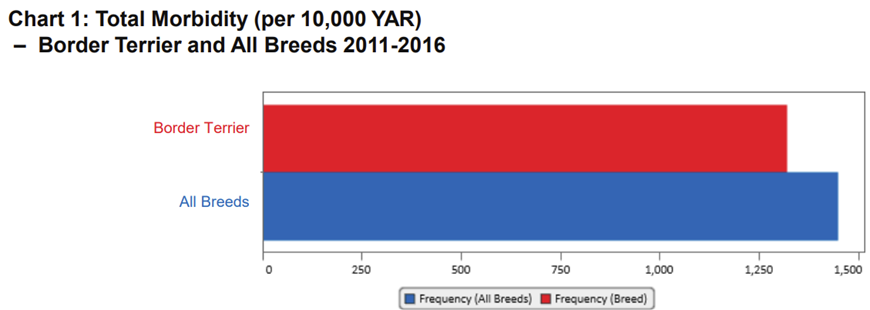


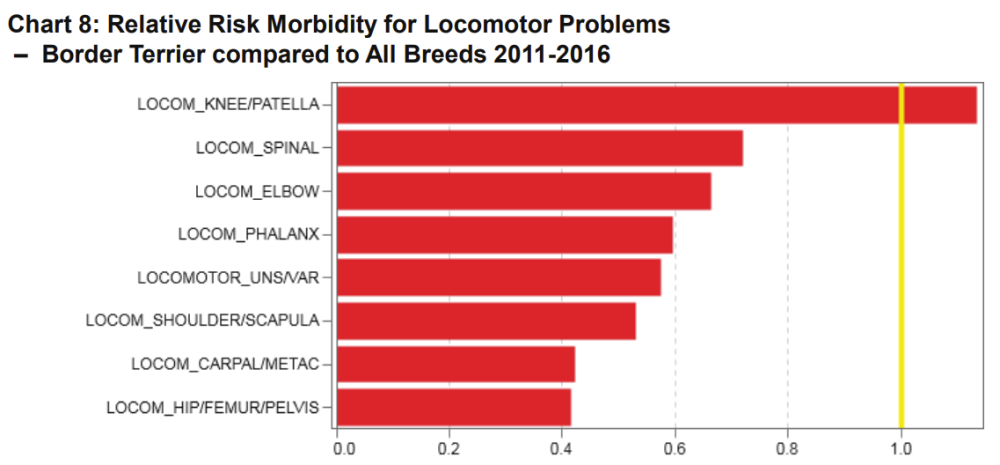
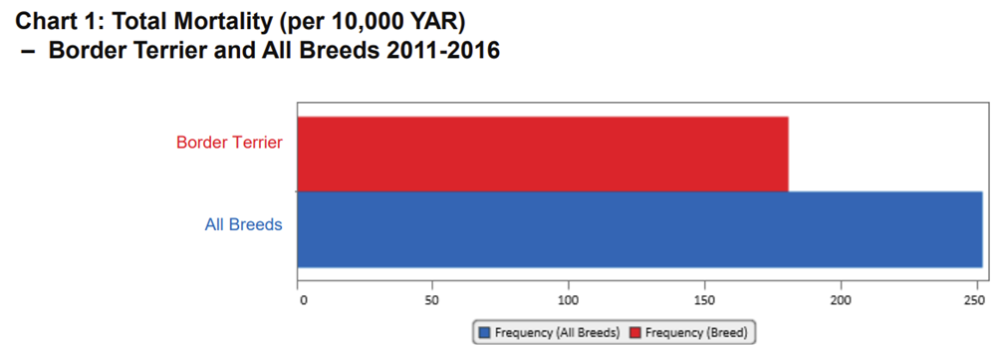
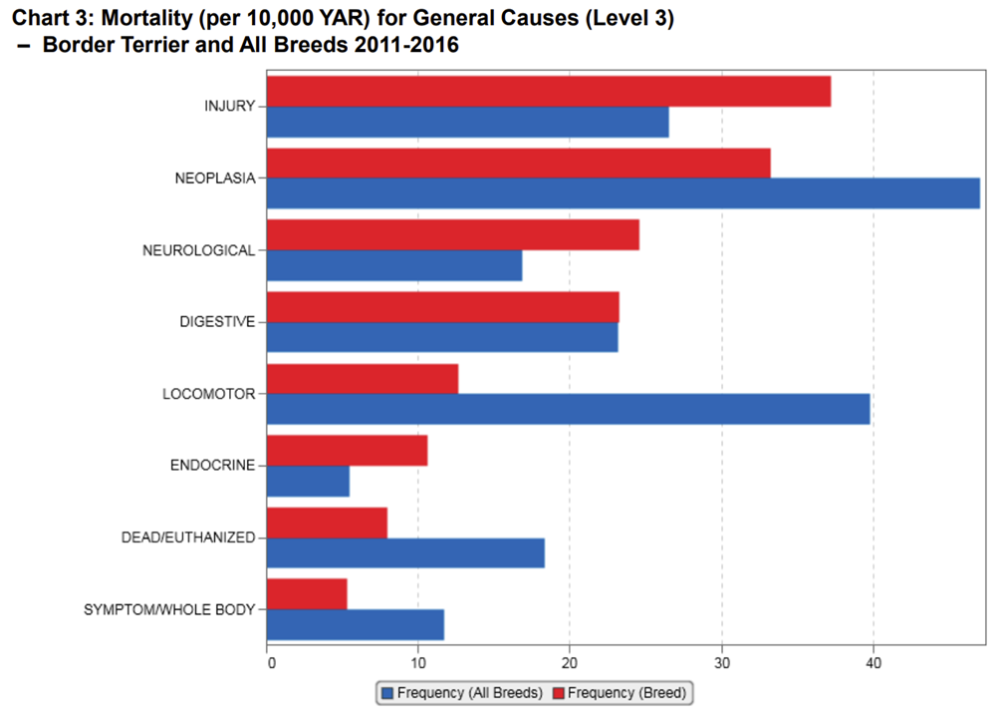
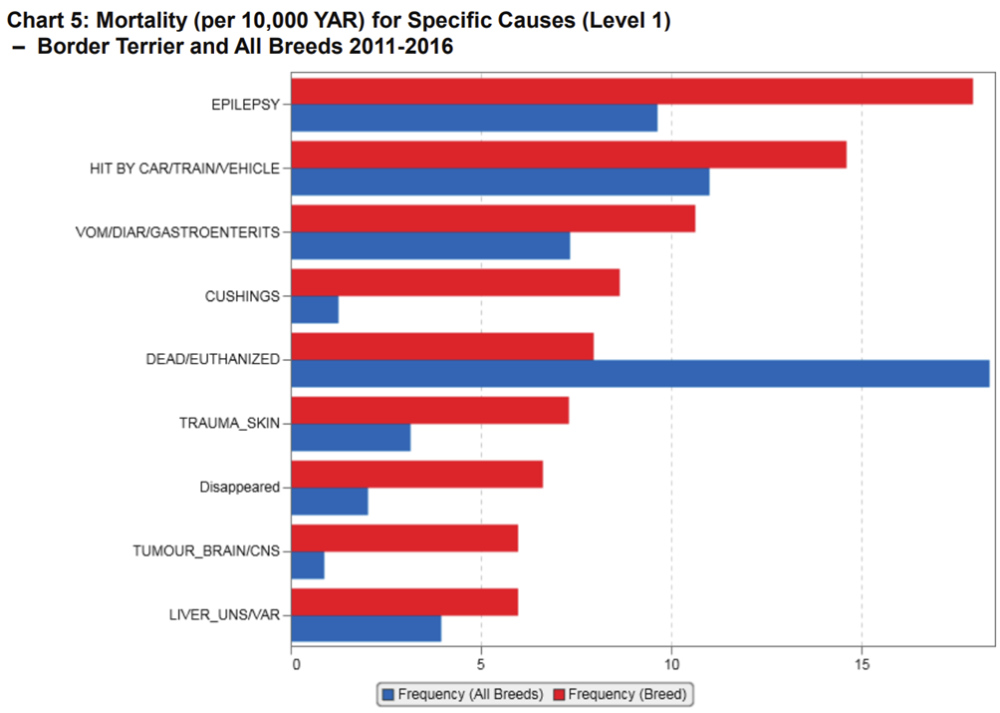



Recommended Comments
There are no comments to display.
Join the conversation
You can post now and register later. If you have an account, sign in now to post with your account.
Note: Your post will require moderator approval before it will be visible.